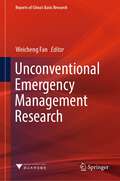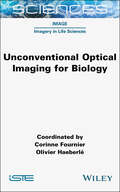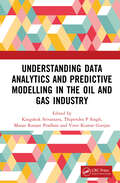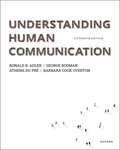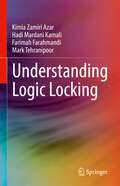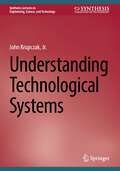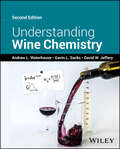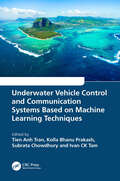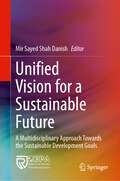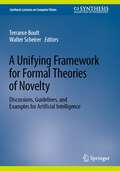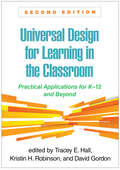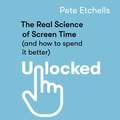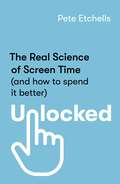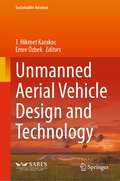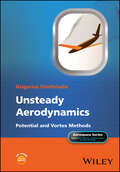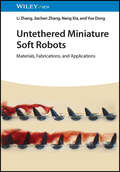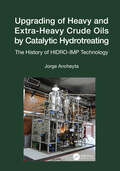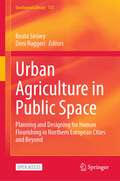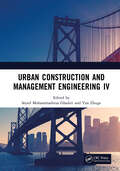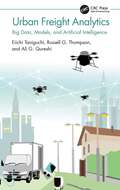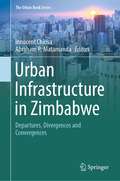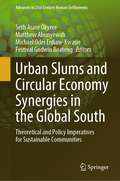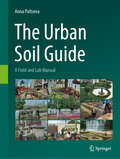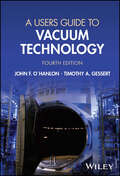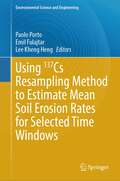- Table View
- List View
Unconventional Emergency Management Research (Reports of China’s Basic Research)
by Weicheng FanThis book mainly introduces the research overview, research results and follow-up prospects of “Unconventional Emergency Management Research”, a major research plan of National Natural Science Foundation of China (hereinafter referred to as the Plan). The Plan has carried out innovative research around major strategic fields and directions on emergency management. A total of 121 projects were funded by the Plan, including 92 Fostering Projects, 25 Key Projects and 4 Integrated Projects, with a total funding of 120 million RMB. From the perspective of major national needs and scientific discipline development, the book focuses on three key scientific issues: information processing and evolution modeling of unconventional emergencies, emergency decision-making theory of unconventional emergencies, and psychological and behavioral response laws of individuals and groups in emergency situations. The publication of this book aims to provide more powerful support for the research and exploration in public security and emergency management.
Unconventional Optical Imaging for Biology
by Corinne Fournier Olivier HaeberléOptical imaging of biological systems has undergone spectacular development in recent years, producing a quantity and a quality of information that, just twenty years ago, could only be dreamed of by physicists, biologists and physicians. Unconventional imaging systems provide access to physical quantities – phase, absorption, optical index, the polarization property of a wave or the chemical composition of an object – not accessible to conventional measurement systems. To achieve this, these systems use special optical setups and specific digital image processing to reconstruct physical quantities. This field is also known as computational imaging. This book presents various non-conventional imaging modalities developed for the biomedical field: wave front analysis imaging, digital holography/tomography, optical nanoscopy, endoscopy and singlesensor imaging. Experimental setups and reconstruction algorithms are presented for each modality.
Understanding Data Analytics and Predictive Modelling in the Oil and Gas Industry
by Kingshuk Srivastava, Thipendra P Singh, Manas Ranjan Pradhan and Vinit Kumar GunjanThis book covers aspects of data science and predictive analytics used in the oil and gas industry by looking into the challenges of data processing and data modelling unique to this industry. It includes upstream management, intelligent/digital wells, value chain integration, crude basket forecasting, and so forth. It further discusses theoretical, methodological, well-established, and validated empirical work dealing with various related topics. Special focus has been given to experimental topics with various case studies. Features: Provides an understanding of the basics of IT technologies applied in the oil and gas sector Includes deep comparison between different artificial intelligence techniques Analyzes different simulators in the oil and gas sector as well as discussion of AI applications Focuses on in-depth experimental and applied topics Details different case studies for upstream and downstream This book is aimed at professionals and graduate students in petroleum engineering, upstream industry, data analytics, and digital transformation process in oil and gas.
Understanding Human Communication
by Ronald B. Adler George Rodman Athena du Prà Copy Barbara Cook OvertonUnderstanding Human Communication addresses students' perception that they already know how to communicate--an issue faced by every faculty member. By artfully weaving cutting-edge academic research and theory into the clear, down-to-earth, and student-friendly narrative, the authors help students understand the complexity and depth of human communication and public speaking. The series of concepts builds logically through the chapter sequence, enabling students to further deepen their communication skills as they progress through the book. By accessing the text's integrated digital resources--contemporary and brief video clips; tutorials; and self-assessments---students will be able to see concepts applied in real scenarios, making their learning more meaningful.
Understanding Logic Locking
by Kimia Zamiri Azar Hadi Mardani Kamali Farimah Farahmandi Mark TehranipoorThis book demonstrates the breadth and depth of IP protection through logic locking, considering both attacker/adversary and defender/designer perspectives. The authors draw a semi-chronological picture of the evolution of logic locking during the last decade, gathering and describing all the DO’s and DON’Ts in this approach. They describe simple-to-follow scenarios and guide readers to navigate/identify threat models and design/evaluation flow for further studies. Readers will gain a comprehensive understanding of all fundamentals of logic locking.
Understanding Technological Systems (Synthesis Lectures on Engineering, Science, and Technology)
by John Krupczak, Jr.This book is about understanding technology using the perspective of systems. It addresses the need for an accessible approach to understanding the broad range of technological devices and systems that create the modern world. Understanding technological systems offers an introduction to engineering and technology centered on the underlying structure common to all technological objects. This framework views technological systems as created using components to provide specific capabilities or functions. Components contributing well-defined functions interact with other components to create systems. Major topics include the concepts of technological function and the embedding of functional capabilities in physical components, the hierarchical nature of systems, and the clustering of related systems into technological domains. The book fills the gap between engineering science and engineering design.
Understanding Wine Chemistry (Sci (society Of Chemical Industry) Ser.)
by Andrew L. Waterhouse Gavin L. Sacks David W. JefferyUnderstanding Wine Chemistry Understand the reactions behind the world’s most alluring beverages The immense variety of wines on the market is the product of multiple chemical processes – whether acting on components arising in the vineyard, during fermentation, or throughout storage. Winemaking decisions alter the chemistry of finished wines, affecting the flavor, color, stability, and other aspects of the final product. Knowledge of these chemical and biochemical processes is integral to the art and science of winemaking. Understanding Wine Chemistry has served as the definitive introduction to the chemical components of wine, their properties, and their reaction mechanisms. It equips the knowledgeable reader to interpret and predict the outcomes of physicochemical reactions involved with winemaking processes. Now updated to reflect recent research findings, most notably in relation to wine redox chemistry, along with new Special Topics chapters on emerging areas, it continues to set the standard in the subject. Readers of the second edition of Understanding Wine Chemistry will also find: Case studies throughout showing chemistry at work in creating different wine styles and avoiding common adverse chemical and sensory outcomes Detailed treatment of novel subjects like non-alcoholic wines, non-glass alternatives to wine packaging, synthetic wines, and more An authorial team with decades of combined experience in wine chemistry research and education Understanding Wine Chemistry is ideal for college and university students, winemakers at any stage in their practice, professionals in related fields such as suppliers or sommeliers, and chemists with an interest in wine.
Underwater Vehicle Control and Communication Systems Based on Machine Learning Techniques
by Tien Anh Tran Kolla Bhanu Prakash Subrata Chowdhury Ivan Ck TamThe development of intelligent transportation systems, especially autonomous underwater vehicles, has become significant in marine engineering, with an aim to enhance energy efficiency management and communication systems. This book covers different aspects of optimization of autonomous underwater vehicles and their propulsion systems via machine learning techniques. It further analyses hydrodynamic characteristics including the study of experimental investigation combined with hydrodynamic characteristics backed by MATLAB® codes and simulation study results. Features: Covers utilization of machine learning techniques with a focus on marine science and ocean engineering. Details effect of the intelligent transportation system (ITS) into the sustainable environment and ecology system. Evaluates performance of particle swarm intelligence-based optimization techniques. Reviews propulsion performance of the remote-controlled vehicles based on machine learning techniques. Includes MATLAB® examples and simulation study results. This book is aimed at graduate students and researchers in marine engineering and technology, computer science, and control system engineering.
Unified Vision for a Sustainable Future: A Multidisciplinary Approach Towards the Sustainable Development Goals
by Mir Sayed Shah DanishUnified Vision for a Sustainable Future: A Multidisciplinary Approach Towards the Sustainable Development Goals focuses on energy and the environment, highlighting interdisciplinary research, innovative strategies, and global initiatives presented at the International Conference on Collaborative Endeavors for Global Sustainability (CEGS 2024). The book explores the various pillars of sustainability – environmental, social, institutional, technical, and economic – and provides readers with case studies, practical solutions, and models for the UN’s Sustainable Development Goals. The book further examines the implications of these initiatives, analyzing their potential for long-lasting, sustainable impact.This book will appeal to a broad readership. Academics, researchers, policymakers, sustainability advocates, and anyone interested in global sustainability will find the book insightful.
A Unifying Framework for Formal Theories of Novelty: Discussions, Guidelines, and Examples for Artificial Intelligence (Synthesis Lectures on Computer Vision)
by Terrance Boult Walter ScheirerThis book presents the first unified formalization for defining novelty across the span of machine learning, symbolic-reasoning, and control and planning-based systems. Dealing with novelty, things not previously seen by a system, is a critical issue for building vision-systems and general intelligent systems. The book presents examples of using this framework to define and evaluate in multiple domains including image recognition image-based open world learning, hand-writing and author analysis, CartPole Control, Image Captioning, and Monopoly. Chapters are written by well-known contributors to this new and emerging field. In addition, examples are provided from multiple areas, such as machine-learning based control problems, symbolic reasoning, and multi-player games.
Universal Design for Learning in the Classroom: Practical Applications for K-12 and Beyond
by Tracey E. Hall Kristin H. Robinson David GordonThe Universal Design for Learning (UDL) framework has grown from its origins in special education to being widely used to support all students, making the fully rewritten second edition of this indispensable guide more relevant than ever. Filled with practical, vivid examples and tips, the book demonstrates the power of UDL when applied to particular content areas. Specific teaching ideas are presented for literacy, STEM, project-based learning, career and technical education, and the arts. The editors and contributors describe practical ways to create thriving learning environments that use UDL to meet diverse learners' needs. New to This Edition *Entirely new content. *Coverage expanded from elementary and middle grades to secondary and beyond. *Innovative approaches embracing the growth of UDL and the ubiquity of digital technologies in today&’s classrooms. *Spotlight on issues of equity and inclusion. *Chapters on antiracism, social–emotional learning, career and technical education, journey mapping, and curriculum design. *Compelling discussions of advances in UDL principles and research directions.
Unlocked: The Real Science of Screen Time (and how to spend it better)
by Pete Etchells'A welcome counterpoint to the technopanic that screen time is causing a mental health crisis' Bruce Hood 'A rare mix of trustworthy science, practical advice, and human stories ... I'm going to recommend it to all the parents I know, and keep it handy for reference next time I see a scary headline about how technology is ruining our lives' Timandra HarknessMost of us spend a significant part of the day in front of a screen. Our work and social lives play out through our computers, tablets and phones: on email, social media, video conference calls and gaming servers. But what is all this screen time doing to our health, our sleep, and our relationships?Professor Pete Etchells studies the way we use screens, and how they can affect us. In UNLOCKED, he delves into the real science behind the panic about our alleged device addiction and withering attention spans. Armed with the latest research, he reveals how little we have to fear, and the great deal we have to gain, by establishing a more positive relationship with our screens. That begins with asking ourselves some essential questions about how we use them.Instead of clamouring for us to ditch our devices (before guiltily returning to the same old habits), UNLOCKED is a sustainable, realistic and vital guide to transforming our connection with technology.
Unlocked: The Real Science of Screen Time (and how to spend it better)
by Pete Etchells'A welcome counterpoint to the technopanic that screen time is causing a mental health crisis' Bruce Hood 'A rare mix of trustworthy science, practical advice, and human stories ... I'm going to recommend it to all the parents I know, and keep it handy for reference next time I see a scary headline about how technology is ruining our lives' Timandra HarknessMost of us spend a significant part of the day in front of a screen. Our work and social lives play out through our computers, tablets and phones: on email, social media, video conference calls and gaming servers. But what is all this screen time doing to our health, our sleep, and our relationships?Professor Pete Etchells studies the way we use screens, and how they can affect us. In UNLOCKED, he delves into the real science behind the panic about our alleged device addiction and withering attention spans. Armed with the latest research, he reveals how little we have to fear, and the great deal we have to gain, by establishing a more positive relationship with our screens. That begins with asking ourselves some essential questions about how we use them.Instead of clamouring for us to ditch our devices (before guiltily returning to the same old habits), UNLOCKED is a sustainable, realistic and vital guide to transforming our connection with technology.
Unmanned Aerial Vehicle Design and Technology (Sustainable Aviation)
by T. Hikmet Karakoc Emre ÖzbekUnmanned Aerial Vehicle Design and Technology provides readers with a comprehensive introduction to unmanned aerial systems (UAS) technology basics. The book presents clear, concise guidance on UAS system design, components, control, and operations fundamentals. Additional chapters look at unmanned aerial regulations and ethics and the historical background of UAS technology. This textbook offers a well-rounded look at unmanned flight technology, making it an ideal primer for aviation and aerospace students and anyone interested in learning more about unmanned aerial systems, including engineers, technicians, drone and flight hobbyists, and civil aviation organization officials.
Unsteady Aerodynamics: Potential and Vortex Methods (Aerospace Series)
by Grigorios DimitriadisUnsteady Aerodynamics A comprehensive overview of unsteady aerodynamics and its applications The study of unsteady aerodynamics goes back a century and has only become more significant as aircraft become increasingly sophisticated, fly faster, and their structures are lighter and more flexible. Progress in the understanding of flow physics, computing power and techniques, and modelling technologies has led to corresponding progress in unsteady aerodynamics, with a wide range of methods currently used to predict the performance of engineering structures under unsteady conditions. Unsteady Aerodynamics offers a comprehensive and systematic overview of the application of potential and vortex methods to the subject. Beginning with an introduction to the fundamentals of unsteady flow, it then discusses the modelling of attached and separated, incompressible and compressible flows around two-dimensional and three-dimensional bodies. The result is an essential resource for design and simulation in aerospace engineering. Unsteady Aerodynamics readers will also find: MATLAB examples and exercises throughout, with codes and solutions on an accompanying website Detailed discussion of most classes of unsteady phenomena, including flapping flight, transonic flow, dynamic stall, flow around bluff bodies and more Validation of theoretical and numerical predictions using comparisons to experimental data from the literature Unsteady Aerodynamics is ideal for researchers, engineers, and advanced students in aerospace engineering.
Untethered Miniature Soft Robots: Materials, Fabrications, and Applications
by Li Zhang Jiachen Zhang Neng Xia Yue DongUntethered Miniature Soft Robots Reference on achieving contactless manipulation of soft robots, detailing high level concepts and perspectives and technical skills of soft robots Untethered Miniature Soft Robots: Materials, Fabrications, and Applications introduces the emerging field of miniature soft robots and summarizes the recent rapid development in the field to date, describing different types of functional materials to build miniature soft robots, such as silicone elastomer, carbon-based materials, hydrogels, liquid crystal polymer, flexible ferrofluid, and liquid metal, and covering the material properties, fabrication strategies, and functionalities in soft robots together with their underlying mechanisms. The book discusses magnetically, thermally, optically, and chemically actuated soft robots in depth, explores the many specific applications of miniature soft robots in biomedical, environmental, and electrical fields and summarizes the development of miniature soft robots based on soft matter, fabrication strategies, locomotion principles, sensing and actuation mechanisms. In closing, the text summarizes the opportunities and challenges faced by miniature soft robots, providing expert insight into the possible futures of this field. Written by four highly qualified academics, Untethered Miniature Soft Robots covers sample topics such as: Soft elastomer-based robots with programmable magnetization profiles and untethered soft robots based on template-aiding Working mechanisms of carbon-based materials, covering light-induced expansion and shrinkage, and humidity-induced deformation Designing microscale building blocks, modular assembly of building blocks based on Denavit-Hartenberg (DH) matrix, and inverse and forward design of modular morphing systems Material designs of magnetic liquid crystal elastomers (LCE) systems, multiple-stimuli responsiveness of magnetic LCE systems, and adaptive locomotion of magnetic LCE-based robots Controllable deformation and motion behaviors, as well as applications of ferrofluids droplet robots (FDRs), including cargo capturing, object sorting, liquid pumping/mixing, and liquid skin. Providing highly detailed and up-to-date coverage of the topic, Untethered Miniature Soft Robots serves as an invaluable and highly comprehensive reference for researchers working in this promising field across a variety of disciplines, including materials scientists, mechanical and electronics engineers, polymer chemists, and biochemists.
Upgrading of Heavy and Extra-Heavy Crude Oils by Catalytic Hydrotreating: The History of HIDRO-IMP Technology
by Jorge AncheytaThis book explores the common approaches to upgrade heavy and extra-heavy crude oils by means of catalytic hydrotreating, emphasizing hydrogen addition technology as well as carbon rejection alternatives. Kinetic and reactor models are combined with experimental data to simulate and optimize commercial-scale reactor performance. Key Features• Focuses on fixed-bed catalytic hydrotreating and catalysts and process scheme characteristics for commercial application.• Guides readers on hydrotreating process technology development from batch reactor experiments to semi-commercial test.• Describes step-by-step methodologies for development of kinetic models based on experimental data generated at different reaction scales.• Provides detailed explanation on how to formulate a reactor model for the simulation of catalytic hydrotreating of heavy oils. A comprehensive guide to the upgrading of crude oils, this book has particular appeal for petroleum refining industry professionals, catalyst developers, workshop instructors, professors, and their graduate and postgraduate students.
Urban Agriculture in Public Space: Planning and Designing for Human Flourishing in Northern European Cities and Beyond (GeoJournal Library #132)
by Deni Ruggeri Beata SirowyThis open access book discusses urban agriculture initiatives integrated in public space of dense inner-city neighbourhoods, thereby ensuring its accessibility for large and diverse segments of urban populations. It specifically focuses on the potential impacts of urban agriculture on human well-being (both on individual and community levels), and how planning, design, policy and management practices can maximize these impacts. The book addresses urban agriculture on both a micro and macro scale to facilitate a transition to more sustainable lifestyles and enhance the quality of urban life. It also discusses ways to permanently integrate urban agriculture in existing and planned public spaces in a visually attractive, socially inclusive, and democratic manner to claim and reclaim the right to the city. Based on the research outcomes of the project “Cultivating Public Space: urban agriculture as a basis for human flourishing and sustainability transition in Norwegian cities” funded by the Research Council of Norway, the book emerges from a Norwegian context, but extends to include international urban agriculture cases from the Netherlands, Denmark, the UK and more. By including a diversity of voices and cultural perspectives, the editors aimed to make this book engaging and relevant to an international audience of researchers, policy makers, urban designers, planners, educators, community activists, residents, and public space users of the sustainable, compact city of today and the future.
Urban Construction and Management Engineering IV
by Seyed Mohammadreza Ghadiri Zhuge YanUrban Construction and Management Engineering IV focuses on the research of construction technology and the engineering management in urban construction. This proceedings gathers the most cutting-edge research and achievements, and will provide scholars and engineers with preferable research directions and engineering solutions as reference. Subjects in this proceedings include: Civil Engineering Engineering Structure Engineering Management Low Carbon City Urban Management The works of this proceedings encourages development of civil engineering and construction technology. Thereby, the work promotes scientific information interchange between scholars from the top universities, research centers and high-tech enterprises working all around the world.
Urban Freight Analytics: Big Data, Models, and Artificial Intelligence
by Eiichi Taniguchi Russell G. Thompson Ali G. QureshiUrban Freight Analytics examines the key concepts associated with the development and application of decision support tools for evaluating and implementing city logistics solutions. New analytical methods are required for effectively planning and operating emerging technologies including the Internet of Things (IoT), Information and Communication Technologies (ICT), and Intelligent Transport Systems (ITS). The book provides a comprehensive study of modelling and evaluation approaches to urban freight transport. It includes case studies from Japan, the US, Europe, and Australia that illustrate the experiences of cities that have already implemented city logistics, including analytical methods that address the complex issues associated with adopting advanced technologies such as autonomous vehicles and drones in urban freight transport. Also considered are future directions in urban freight analytics, including hyperconnected city logistics based on the Physical Internet (PI), digital twins, gamification, and emerging technologies such as connected and autonomous vehicles in urban areas. An integrated modelling platform is described that considers multiple stakeholders or agents, including emerging organisations such as PI companies and entities such as crowd-shippers as well as traditional stakeholders such as shippers, receivers, carriers, administrators, and residents. This book Presents procedures for evaluating city logistics technologies and policy measures Provides an overview of advanced modelling approaches, including agent-based model and machine learning Highlights the essential features of optimisation and simulation models applied to city logistics Discusses how models incorporating more uncertainty and dynamic data can be used to improve the sustainability and resilience of urban freight systems The book is ideal for graduate students in civil and environmental engineering and logistics management, urban planners, transport engineers, and logistics specialists.
Urban Infrastructure in Zimbabwe: Departures, Divergences and Convergences (The Urban Book Series)
by Innocent Chirisa Abraham R. MatamandaThe book provides insights into urban infrastructure debates and discourses in Zimbabwe. Through an inter-disciplinary and multi-disciplinary approach, the book explores the theoretical, conceptual and lived experiences in urban infrastructure. The book focuses on case studies relating to urban transport, public housing, water and sanitation and Geographical Information Systems (GIS) among other substantive issues relating to urban infrastructure and services.
Urban Slums and Circular Economy Synergies in the Global South: Theoretical and Policy Imperatives for Sustainable Communities (Advances in 21st Century Human Settlements)
by Seth Asare Okyere Matthew Abunyewah Michael Odei Erdiaw-Kwasie Festival Godwin BoatengThis book takes a theoretical and empirical distance from urban slums/low-income settlements as a threat to environmental sustainability and recast them as places where environmentally rehabilitative and circular practices occur—drawing on the theoretical lens of the circular economy (CE). CE is defined as regenerative system that minimizes waste, emission, and energy leakage by slowing, closing, and narrowing material and energy loops. In principle, CE departs from the traditional linear model of take-make-use-dispose. As conceived in urban contexts, circular cities offer possibilities to regenerate natural systems, design out waste, and keep products in use. While the CE key principles of reduce, repair, and reuse are essential to the sustainable and inclusive interventions in urban slums, there is lack of case studies exploring the role of place and agency, especially the slum living-CE nexus in global south contexts. In inequitable urban transitions, a nuanced understanding of thesynergies between urban slums and the circular economy is not only theoretically relevant for reconceptualizing the slum in urban sustainability discourses but also exert policy and practice ramifications to decidedly figure out how the urban slum phenomenon can foster the sustainable and inclusive development of marginal areas through contextual and people-centered initiatives.
The Urban Soil Guide: A Field and Lab Manual
by Anna PaltsevaDelve into the fascinating world of soil science with "The Urban Soil Guide," a comprehensive manual designed for everyone from science beginners to seasoned horticulturists. Whether you're an introductory science student, a passionate gardener, a landscape designer, or a professional horticulturist, this guide is tailored for you. Packed with a variety of hands-on activities, this guide makes learning soil science both accessible and enjoyable. From simple experiments that can be performed in your kitchen to more advanced techniques, it offers a practical approach to understanding soil. Written by a soil scientist, this guide bridges the gap between professional knowledge and amateur enthusiasm. The Urban Soil Guide is versatile enough to serve as a textbook in botanical gardens and university classes, while also being an invaluable resource for amateurs. Choose activities that match your interest and level of expertise. Embark on your journey to becoming a soil expert with The Urban Soil Guide – your hands-on companion in the world of soil science.
A Users Guide to Vacuum Technology
by John F. O'Hanlon Timothy A. GessertA USERS GUIDE TO VACUUM TECHNOLOGY Choose and understand the vacuum technology that fits your project’s needs with this indispensable guide Vacuum technology is used to provide process environments for other kinds of engineering technology, making it an unsung cornerstone of hundreds of projects incorporating analysis, research and development, manufacturing, and more. Since it is very often a secondary technology, users primarily interested in processes incorporating it will frequently only encounter vacuum technology when purchasing or troubleshooting. There is an urgent need for a guide to vacuum technology made with these users in mind. For decades, A User’s Guide to Vacuum Technology has met this need, with a user-focused introduction to vacuum technology as it is incorporated into semiconductor, optics, solar sell, and other engineering processes. With an emphasis on otherwise neglected subjects and on accessibility to the secondary user of vacuum technology, it balances treatment of older systems that are still in use with a survey of the latest cutting-edge technologies. The result promises to continue as the essential guide to vacuum systems. Readers of the fourth edition of A User’s Guide to Vacuum Technology will also find: Expanded treatment of gauges, pumps, materials, systems, and best??operating practices Detailed discussion of cutting-edge topics like ultraclean vacuum and contamination control An authorial team with decades of combined research and engineering experience A User’s Guide to Vacuum Technology is essential for those entering emerging STEM programs, engineering professionals and graduate students working with a huge range of engineering technologies.
Using 137Cs Resampling Method to Estimate Mean Soil Erosion Rates for Selected Time Windows (Environmental Science and Engineering)
by Paolo Porto Emil Fulajtar Lee Kheng HengThis book provides guidelines for using a new approach of resampling the Cs-137 radionuclide tracer which is used to estimate soil erosion rates. The Cs-137 resampling approach will improve significantly the use of the Cs-137 method for assessment of soil erosion, because resampling the radionuclide repeatedly (at least two times, but more sampling campaigns are possible) allows to avoid several methodological difficulties associated with Cs-137 method, namely the problems with small-scale spatial heterogeneity, the question of representativeness of reference site, reference samples, and inappropriate time extent of evaluated period. All these methodological problems are very important for reliability and accuracy of erosion rates estimated by Cs-137 method. If using single sampling approach, the small-scale spatial heterogeneity can be overcome by high number of sampling points, but this is time and labour demanding solution increasing the expenses of the erosion research. The representativeness of reference site is evaluated usually on the basis of expert judgement and knowledge of land use history of studied area, but this approach is often uncertain because the expert judgement can be subjective and the data on land use history is often not sufficient. Further, in many areas an appropriate reference site is not available, what limits the territorial extent of using Cs-137 method. The resampling approach offers its second sampling to be done in a proximate vicinity of the same points sampled during the first sampling campaign. A great advantage is the possibility to decide how long time windows should be investigated. Choosing the time schedule of first and second sampling allows to shorten the time window and adjust it to the study objectives. This is a great improvement of the Cs-137 method, because the time period since the Cs-137 fallout is still growing and thus if using the single sampling approach the results refer to still longer and longer time window(since the Cs-137 fallout until the sampling time), and this period (recently ca 60 years assuming the maximum Cs-137 fallout in 1963) is too long to represent stable land use, because land uses are changing over the time and having the same land use over six decades is rather rare. The improvement of Cs-137 method achieved by resampling approach is significantly contributing to understanding the erosion dynamics and estimating its rates under changing environmental conditions (such as land uses, weather), and it will bring a significant benefit to soil conservation programmes, because Cs-137 method is indispensable for assessing the medium and long term soil erosion rates, and this information is among the basic inputs needed for planning and designing soil conservation measures.
